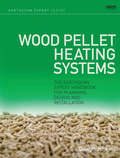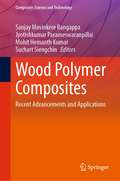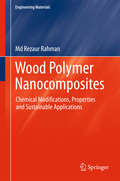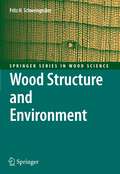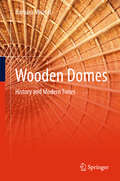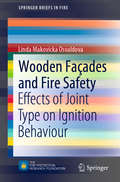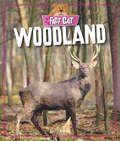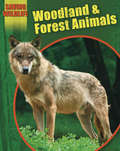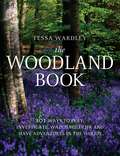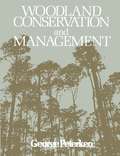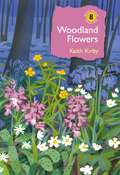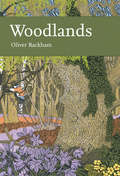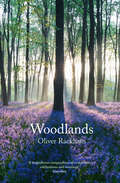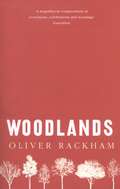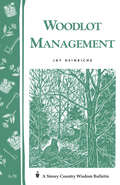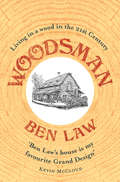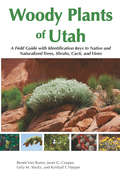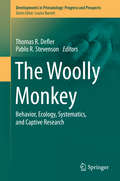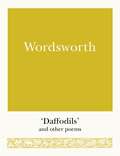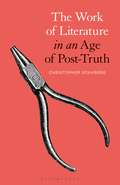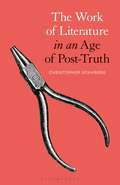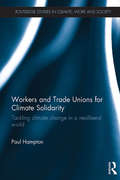- Table View
- List View
Wood Pellet Heating Systems: The Earthscan Expert Handbook on Planning, Design and Installation (Earthscan Expert Ser.)
by Dilwyn JenkinsWood Pellet Heating Systems is a comprehensive handbook covering all aspects of wood pellet heating technology. The use of wood pellets as an alternative heating fuel is already well established in several countries and is becoming widespread as fossil fuel prices continue to rise and awareness of climate change grows. Wood pellets are a carbon-neutral technology, convenient to use, and can easily be integrated into existing central heating systems or used in independent space heaters. This fully-illustrated and easy-to-follow guide shows how wood-pellet heating works, the different types of systems – from small living room stove systems to larger central heating systems for institutions – how they are installed, and even how wood pellets are manufactured. Featuring examples from around the world, it has been written for heating engineers and plumbers who are interested in installing systems, home owners and building managers who are considering purchasing a system, advanced DIYers, building engineers and architects, but will be of interest to anyone who requires a clear guide to wood pellet technology.
Wood Polymer Composites: Recent Advancements and Applications (Composites Science and Technology)
by Sanjay Mavinkere Rangappa Jyotishkumar Parameswaranpillai Mohit Hemanth Kumar Suchart SiengchinThis book comprehensively covers the different topics of wood polymer composite materials mainly synthesis methods for the composite materials, various characterization techniques to study the superior properties and insights on potential advanced applications. It also discusses the chemistry, fabrication process, properties, applications, recycling and life cycle assessment of wood polymer composites. This is a useful reference source for both engineers and researchers working in composite materials science as well as the students attending materials science, physics, chemistry and engineering courses.
Wood Polymer Nanocomposites: Chemical Modifications, Properties and Sustainable Applications (Engineering Materials)
by Md Rezaur RahmanThis book shows how chemical modifications influence some properties of wood nanocomposites. It describes suitable and effective chemical modifications that strengthen the physico-mechanical, thermal and morphological properties of wood. The authors provide intuitive explanation of the various types of chemical modifications applied to polymer cell walls in wood. They emphasize the reaction changes in wood cell walls due to the chemical modifications. Increased mechanical strength, improved thermal stability as well as the efficient retardancy against fungi attack are described. This book concludes summarizing the potential applications of wood-based nanocomposites taking into account sustainability and economic aspects.
Wood Structure and Environment (Springer Series in Wood Science)
by Fritz Hans SchweingruberThe primary aim of Wood Structure and Environment is to reveal the hidden ecological richness in stems and roots from trees, shrubs and herbs. The detailed, lucid text will inspire researchers to consider the anatomic microcosm of wood plants and use it as a retrospective source of information, solving problems related to ecophysiology, competition, site conditions, population biology, earth science, wood quality and even human history.
Wooden Domes: History and Modern Times
by Barbara MisztalThis monograph presents a state-of-the-art analysis of eco-friendly and aesthetic structures in wooden dome construction. The author demonstrates that the further development of wooden structures depends on both supplementing the testing of wood as a heterogeneous material, as well as on further improvement of fibrous structures with visco-elastic properties. The target audience primarily comprises research experts and practitioners in the field of building materials who are interested in innovative architecture.
Wooden Façades and Fire Safety: Effects of Joint Type on Ignition Behaviour (SpringerBriefs in Fire)
by Linda Makovicka OsvaldovaThis book presents the results of an experiment assessing the impact of spruce wood joints on the creation and development of fire when these joints are applied within a façade. The book includes an extensive analysis of wooden cladding, which is a flammable material in which the elements are connected lengthwise using various types of joint. The parameters of the experiment, as well as the setting, material criteria and evaluation criteria are described in detail. The results confirm that the joint type used has an impact on the selected evaluation criteria and thus also on the potential spread of fire.
Woodland: Woodland (Fact Cat: Habitats #1)
by Izzi HowellRead all about woodlands, where in the world you can find them, what animals and plants live there and how these are dependent on each other. Learn about food chains, seasons and what we can do to protect this important habitat.Simple quiz questions at the back help readers to remember what they've just read.
Woodland and Forest Animals: Woodland And Forest Animals (Saving Wildlife)
by Sonya NewlandWoodland & Forest Animals studies creatures under threat in woodland areas, and looks at how conservation is reversing damage caused by human activity and natural disasters.It is part of the Saving Wildlife series, which investigates the world's endangered species in the context of their different environments.
The Woodland Book: 101 ways to play, investigate, watch wildlife and have adventures in the woods
by Tessa WardleyFrom an author passionate about reconnecting both adults and children with nature, The Woodland Book aims to show anyone with an interest in nature and the great outdoors how to make the most of the unique environments provided by a canopy of trees. Packed with fascinating facts about woodlands including ancient rituals and the wildlife and flora that make it special. You'll learn how to identify different kinds of woodland, assess the age of a tree from a stump, recognise the birds that nest in the canopy by their song and meet other creatures such as bats, badgers and even the odd wild boar. Other activities include learning ancient woodland arts such as coppicing, searching for woodland fruits and building your own shelter and mythical 'green man'. Perfect for adults and children who enjoy climbing, investigating, den building, camping and generally having fun, this book will encourage readers to have fun with nature.
The Woodland Book: 101 ways to play, investigate, watch wildlife and have adventures in the woods
by Tessa WardleyFrom an author passionate about reconnecting both adults and children with nature, The Woodland Book aims to show anyone with an interest in nature and the great outdoors how to make the most of the unique environments provided by a canopy of trees. Packed with fascinating facts about woodlands including ancient rituals and the wildlife and flora that make it special. You'll learn how to identify different kinds of woodland, assess the age of a tree from a stump, recognise the birds that nest in the canopy by their song and meet other creatures such as bats, badgers and even the odd wild boar. Other activities include learning ancient woodland arts such as coppicing, searching for woodland fruits and building your own shelter and mythical 'green man'. Perfect for adults and children who enjoy climbing, investigating, den building, camping and generally having fun, this book will encourage readers to have fun with nature.
Woodland Conservation and Management
by G. F. PeterkenProfessor John Harper, in his recent Population Biology of Plants (1977), made a comment and asked a question which effectively states the theme of this book. Noting that 'one of the consequences of the development of the theory of vegetational climax has been to guide the observer's mind forwards', i. e. that 'vegetation is interpreted asa stage on the way to something', he commented that 'it might be more healthy and scientifically more sound to look more often backwards and search for the explanation of the present in the past, to explain systems in relation to their history rather than their goal'. He went on to contrast the 'disaster theory' of plant succession, which holds that communities are a response to the effects of past disasters, with the 'climax theory', that they are stages in the approach to a climax state, and then asked 'do we account most completely for the characteristics of a population by a knowledge of its history or of its destiny?' Had this question been put to R. S. Adamson, E. J. Salisbury, A. G. Tansley or A. S. Watt, who are amongst the giants of the first forty years of woodland ecology in Britain, their answer would surely have been that understanding lies in a knowledge of destiny. Whilst not unaware of the historical facts of British woodlands, they were preoccupied with ideas of natural succession and climax, and tended to interpret their observations in these terms.
Woodland Flowers: Colourful past, uncertain future (British Wildlife Collection)
by Keith KirbyObserving the plants of the forest floor – the flowers, ferns, sedges and grasses – can be a vital way of understanding our relationship with British woodland. They tell us stories about its history and past management, and can be a visible sign of progress when we get conservation right. For centuries, woodland plants have also been part of our lives in practical ways as food and medicines, and they have influenced our culture through poetry, perfume and pub signs.In this insightful and original account, Keith Kirby explores how woodland plants in Great Britain have come to be where they are, coped with living in the shade of their bigger relatives, and responded to threats in the form of storms, fires, floods, the attentions of grazing herbivores and the effects of the changing seasons. Along the way, the reader is introduced to the work of important botanists who have walked the woods in the past, collecting information on where plants occur and why. In-depth profiles of some of our most important and popular ground flora species provide extra detail and insight. Beautifully illustrated, Woodland Flowers is a must for anyone who appreciates and wants to learn more about British woodland and its plants.
Woodland Flowers: Colourful past, uncertain future (British Wildlife Collection)
by Keith KirbyObserving the plants of the forest floor – the flowers, ferns, sedges and grasses – can be a vital way of understanding our relationship with British woodland. They tell us stories about its history and past management, and can be a visible sign of progress when we get conservation right. For centuries, woodland plants have also been part of our lives in practical ways as food and medicines, and they have influenced our culture through poetry, perfume and pub signs.In this insightful and original account, Keith Kirby explores how woodland plants in Great Britain have come to be where they are, coped with living in the shade of their bigger relatives, and responded to threats in the form of storms, fires, floods, the attentions of grazing herbivores and the effects of the changing seasons. Along the way, the reader is introduced to the work of important botanists who have walked the woods in the past, collecting information on where plants occur and why. In-depth profiles of some of our most important and popular ground flora species provide extra detail and insight. Beautifully illustrated, Woodland Flowers is a must for anyone who appreciates and wants to learn more about British woodland and its plants.
Woodlands: Its History, Vegetation And Uses In England (Collins New Naturalist Library #100)
by Oliver RackhamThe 100th volume of the prestigious New Naturalist series, written by one of Britain's best-known naturalists, explores the significance and history of woodlands on the British landscape
Woodlands: Its History, Vegetation And Uses In England (Collins New Naturalist Library #100)
by Oliver Rackham‘Trees are wildlife just as deer or primroses are wildlife. Each species has its own agenda and its own interactions with human activities …’
Woodlands (PDF)
by Oliver Rackham‘Trees are wildlife just as deer or primroses are wildlife. Each species has its own agenda and its own interactions with human activities …’ Written by one of Britain’s best-known naturalists, Woodlands offers a fascinating new insight into the trees of the British landscape that have filled us with awe and inspiration throughout the centuries. Looking at such diverse evidence as the woods used in buildings and ships, and how woodland has been portrayed in pictures and photographs, Rackham traces British woodland through the ages, from the evolution of wildwood, through man’s effect on the landscape, modern forestry and its legacy, and recent conservation efforts and their effects. In his lively and thoroughly engaging style, Rackham explores woodlands and their history, through names, surveys, mapping and legal documents, archaeology, photographs and works of art, thus offering an utterly compelling insight into British woodlands and how they have come to shape a national obsession.
Woodlot Management: Storey's Country Wisdom Bulletin A-70 (Storey Country Wisdom Bulletin)
by Jay HeinrichSince 1973, Storey's Country Wisdom Bulletins have offered practical, hands-on instructions designed to help readers master dozens of country living skills quickly and easily. There are now more than 170 titles in this series, and their remarkable popularity reflects the common desire of country and city dwellers alike to cultivate personal independence in everyday life.
Woodsman: Living In A Wood In The 21st Century
by Ben LawBen Law’s incredible sense of the land and his respect for age old traditions offers a wonderful insight into the life of Prickly Nut Wood.
Woody Plants of Utah: A Field Guide with Identification Keys to Native and Naturalized Trees, Shrubs, Cacti, and Vines
by Renee Van Buren Janet G. Cooper Leila M. Shultz Kimball T. HarperA comprehensive guide that includes a vast range of species and plant communities and employs thorough, original keys. Based primarily on vegetative characteristics, the keys don't require that flowers or other reproductive features be present, like many plant guides. And this guide's attention to woody plants as a whole allows one to identify a much greater variety of plants. That especially suits an arid region such as Utah with less diverse native trees. Woody plants are those that have stems that persist above ground even through seasons that don't favor growth, due to low precipitation or temperatures. Woody Plants of Utah employs dichotomous identification keys that are comparable to a game of twenty questions. They work through a process of elimination by choosing sequential alternatives. Detailed, illustrated plant descriptions complement the keys and provide additional botanical and environmental information in relation to a useful introductory categorization of Utah plant communities. Supplementary tools include photos, distribution maps, and an illustrated glossary.
The Woolly Monkey: Behavior, Ecology, Systematics, and Captive Research (Developments in Primatology: Progress and Prospects #Vol. 39)
by Thomas R. Defler Pablo R. StevensonWoolly monkeys are large, attractive and widespread primates found throughout many parts of the Amazon basin. It is only in the last twenty-five years or so that long-term studies of woollies in their forest habitat have been successful; they have not generally been successfully kept in captivity. But now, especially because of their size, these creatures are pressed on all sides by bush meat hunters and forest fragmentation. Their future is becoming critically precarious and the editors feel that it is time to showcase these animals with a full book.The editors draw together a number of recent woolly monkey studies from three Amazonian countries, including five taxa of woolly monkeys, four of which have recently been reclassified without using new biological criteria as species rather than subspecies (Groves, 2001, 2005; Rylands & Mittermeier, 2009). This volume provides a diversity of studies by well-known researchers and advanced students on a wide range of subjects using newly generated data, including a criticism of the recent taxonomic changes. The varied information contained within The Woolly Monkey: Behavior, Ecology, Systematics and Captive Research will help readers understand these handsome animals and will, we hope, energize them to contribute to their conservation.
Wordsworth: 'Daffodils' and Other Poems (Pocket Poets #4)
by William WordsworthWilliam Wordsworth is chiefly remembered as one of the ‘Lake Poets’. Yet he was also one of the founders of English Romanticism, a writer whose early revolutionary fervor imbued his verse and his ideals.Much of Wordsworth’s work was inspired by nature, but to a style rich in lyrical imagery he brought a deep interest in liberal humanitarianism and a profound concern for the lives, habits and speech of ordinary people, especially country people.This pocket-sized collection includes: ‘I wandered lonely as a cloud’ (‘Daffodils’), ‘Ode. Intimations of Immortality’, ‘Character of the Happy Warrior’, ‘The Solitary Reaper’, ‘To a Sky-Lark’, ‘Tintern Abbey’, and extracts from ‘The Prelude’.
The Work of Literature in an Age of Post-Truth
by Christopher SchabergWhat is the role of literary studies in an age of Twitter threads and viral news?If the study of literature today is not just about turning to classic texts with age-old questions, neither is it a rejection of close reading or critical inquiry. Through the lived experience of a humanities professor in a rapidly changing world, this book explores how the careful study of literature and culture may be precisely what we need to navigate our dizzying epoch of post-truth politics and ecological urgency.
The Work of Literature in an Age of Post-Truth: Holy Places In Louisiana
by Christopher SchabergWhat is the role of literary studies in an age of Twitter threads and viral news?If the study of literature today is not just about turning to classic texts with age-old questions, neither is it a rejection of close reading or critical inquiry. Through the lived experience of a humanities professor in a rapidly changing world, this book explores how the careful study of literature and culture may be precisely what we need to navigate our dizzying epoch of post-truth politics and ecological urgency.
Workers and Trade Unions for Climate Solidarity: Tackling climate change in a neoliberal world (Routledge Studies in Climate, Work and Society)
by Paul HamptonThis book is a theoretically rich and empirically grounded account of UK trade union engagement with climate change over the last three decades. It offers a rigorous critique of the mainstream neoliberal and ecological modernisation approaches, extending the concepts of Marxist social and employment relations theory to the climate realm. The book applies insights from employment relations to the political economy of climate change, developing a model for understanding trade union behaviour over climate matters. The strong interdisciplinary approach draws together lessons from both physical and social science, providing an original empirical investigation into the climate politics of the UK trade union movement from high level officials down to workplace climate representatives, from issues of climate jobs to workers’ climate action. This book will be of great interest to students and researchers in environmental politics, climate change and environmental sociology.
Workers and Trade Unions for Climate Solidarity: Tackling climate change in a neoliberal world (Routledge Studies in Climate, Work and Society)
by Paul HamptonThis book is a theoretically rich and empirically grounded account of UK trade union engagement with climate change over the last three decades. It offers a rigorous critique of the mainstream neoliberal and ecological modernisation approaches, extending the concepts of Marxist social and employment relations theory to the climate realm. The book applies insights from employment relations to the political economy of climate change, developing a model for understanding trade union behaviour over climate matters. The strong interdisciplinary approach draws together lessons from both physical and social science, providing an original empirical investigation into the climate politics of the UK trade union movement from high level officials down to workplace climate representatives, from issues of climate jobs to workers’ climate action. This book will be of great interest to students and researchers in environmental politics, climate change and environmental sociology.
